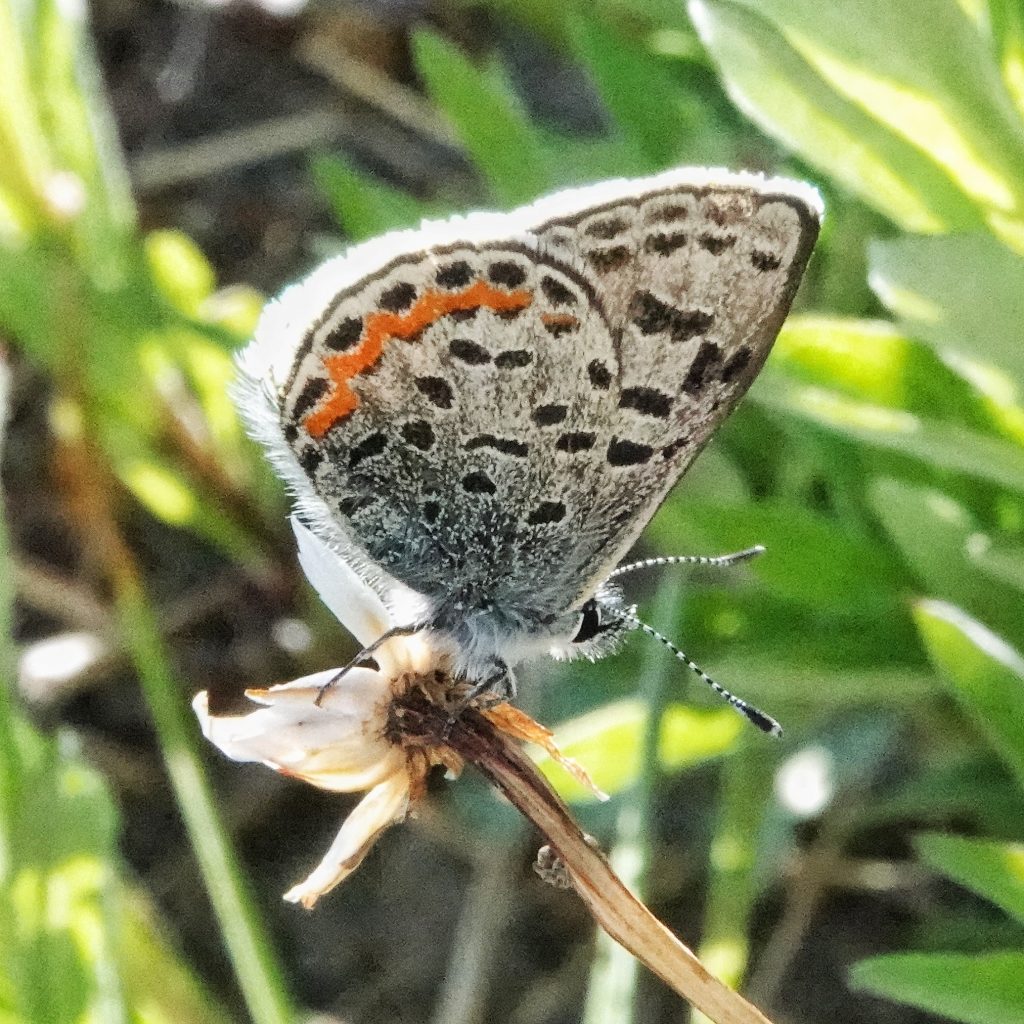
As soon as I was sure that I was looking at masses of Eriogonum umbellatum (Sulphur-flower Buckwheat) on my first trip to Mt. Hood this year I started really hoping that I would find some Euphilotes glaucon (summit blues) butterflies, and almost immediately I did, although I wasn’t actually positive what species of buckwheat blues they were. I managed to get some good closeup photos of these butterflies, and soon after I got home I sent cropped and edited photos to three of the butterfly experts who have been kind (or foolish) enough to have given me contact information. One said he wasn’t sure because studies are ongoing, but the other two confirmed them as E. glaucon, and one of them, Merrill Peterson, is one of the people studying the buckwheat blues, and he asked me to collect some for him. Which I happily did soon afterward.
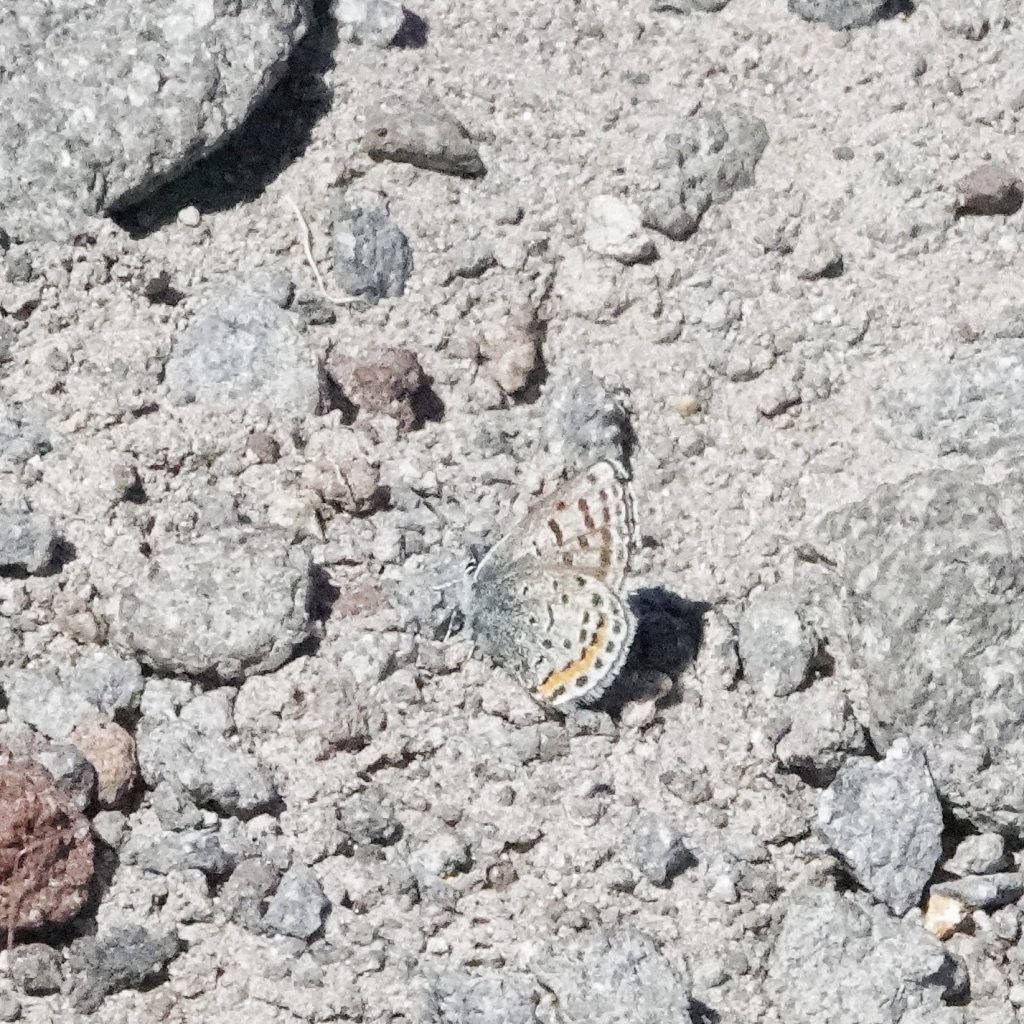
The little blues in the genus Euphilotes are fascinating for a few reasons. For one thing they are very closely tied to particular species of Eriogonum (wild buckwheat) and use them in all phases of their life, as well as tying those phases to the reproductive periods of those plants. As I should have mentioned in the profile of Eriogonum umbellatum (Sulphur-flower Buckwheat) “Eriogonum(Wild Buckwheat), is a complex genus containing about 250 species nearly confined to the western half of North America (Reveal, 1969). These plants are believed to have undergone rapid evolution as a result of the drying trend of the West during the Pliocene and Holocene (Shields & Reveal, 1988). Today, various Eriogonum species occur in nearly every non-hydric soil habitat in the southwestern US., from below sea level to over 4000 meters. Although most species bloom annually and fruit for approximately four to six weeks, flowering/ fruiting periods for different species range from March to November…During the last 20000 years great coordinated changes in climate and plant distributions occurred in western North America due to the retreat of the Wisconsin glacier (Van Devender & Spaulding, 1979). The distributions of Eriogonum species also undoubtedly changed in response to these climatic changes, which in turn caused distributional changes in Euphilotes taxa. In some cases local host extinctions may have caused shifts to hosts with similar or different bloom periods. Temperature changes and alternating periods of drought and abundant rain in the deserts may have caused changes in host bloom time, which also may have caused host shifts and/or seasonal shifts in adult activity. In other cases local host extinctions may have caused corresponding extinctions of Euphilotes populations, which created genetic bottlenecks in isolated populations or founder effects by subsequent recolonization…Euphilotesevolution may have occurred by gradual adaptation to hosts with increasingly greater physical and/or chemical defences as ‘Sequential Evolution’ (Jermy, 1984), and/or by random adaptation to unoccupied niches (new hosts with different bloom periods) and tracking of gradual evolutionary changes in host bloom time in response to changing environmental conditions. These adaptations may have occurred in allopatry or sympatry. Sci-Hub | Evolution of <em>Euphilotes</em> (Lepidoptera: Lycaenidae) by seasonal and host shifts | 10.1111/j.1095-8312.1994.tb00970.x.
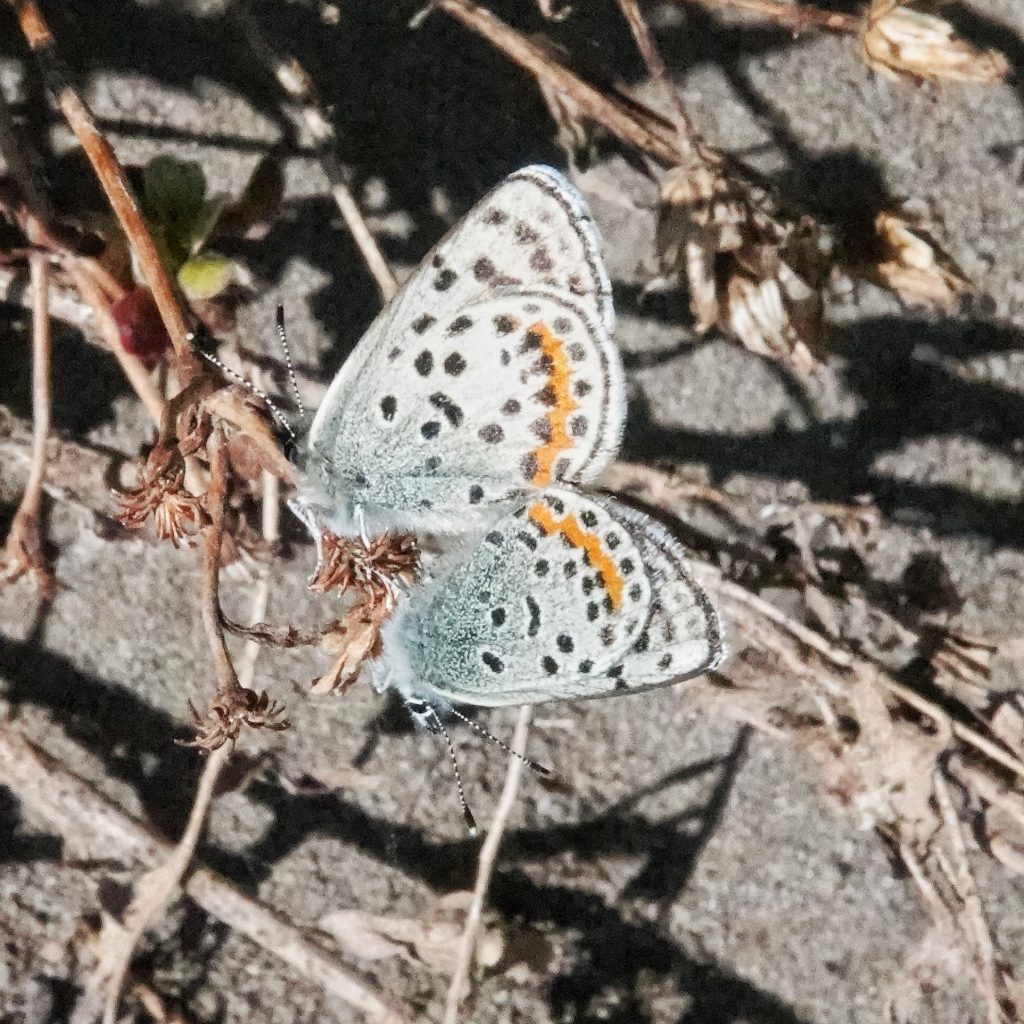
The upshot of which is that there are many more species of Euphilotes than were originally thought, with many former subspecies (such as E. glaucon) being raised to full species status. Since not only is the revising of this genus still ongoing, but the evolutionary speciation continues to happen also, possibly exacerbated by global warming, it is very exciting to be able to help contribute to the database for these butterflies. And so by keeping my eyes open for any blooming Eriogonum plants, and searching them for any beautiful little (and these are tiny butterflies, with wingspans under an inch) Euphilotes blues, it is possible that even a recreational naturalist such as myself can help add to the knowledge of the world and how it all works.
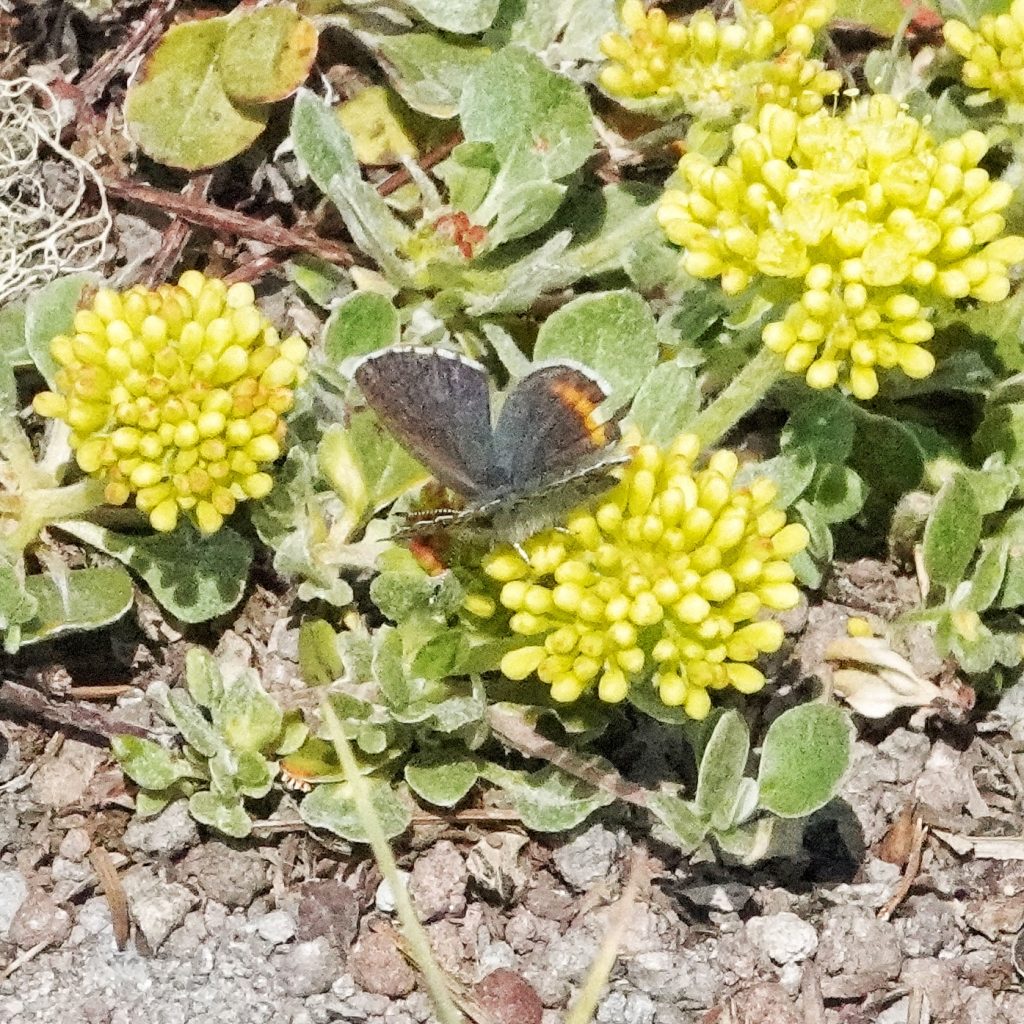
A couple things that I didn’t notice the first day that I found these butterflies, but that became very apparent once I was trying to make sure I got mostly males for Merrill, is that there is (or at least was on the day I was looking) at least a 3 or 4 to 1 ratio of females to males on the E. umbellatum plants themselves. The males seemed to much prefer perching on the sand/gravel substrate near the sulphur buckwheat, or were found mudding at damp ground near a watercourse that only actually ran later in the day once the snow at its head had melted sufficiently to produce streamflow.Another thing I noticed was that the females frequently perch with their wings spread to some extent, while the males seldom do (a behavioral observation that I later found validated by Dennis Walker on Euphilotes glaucon comstocki)
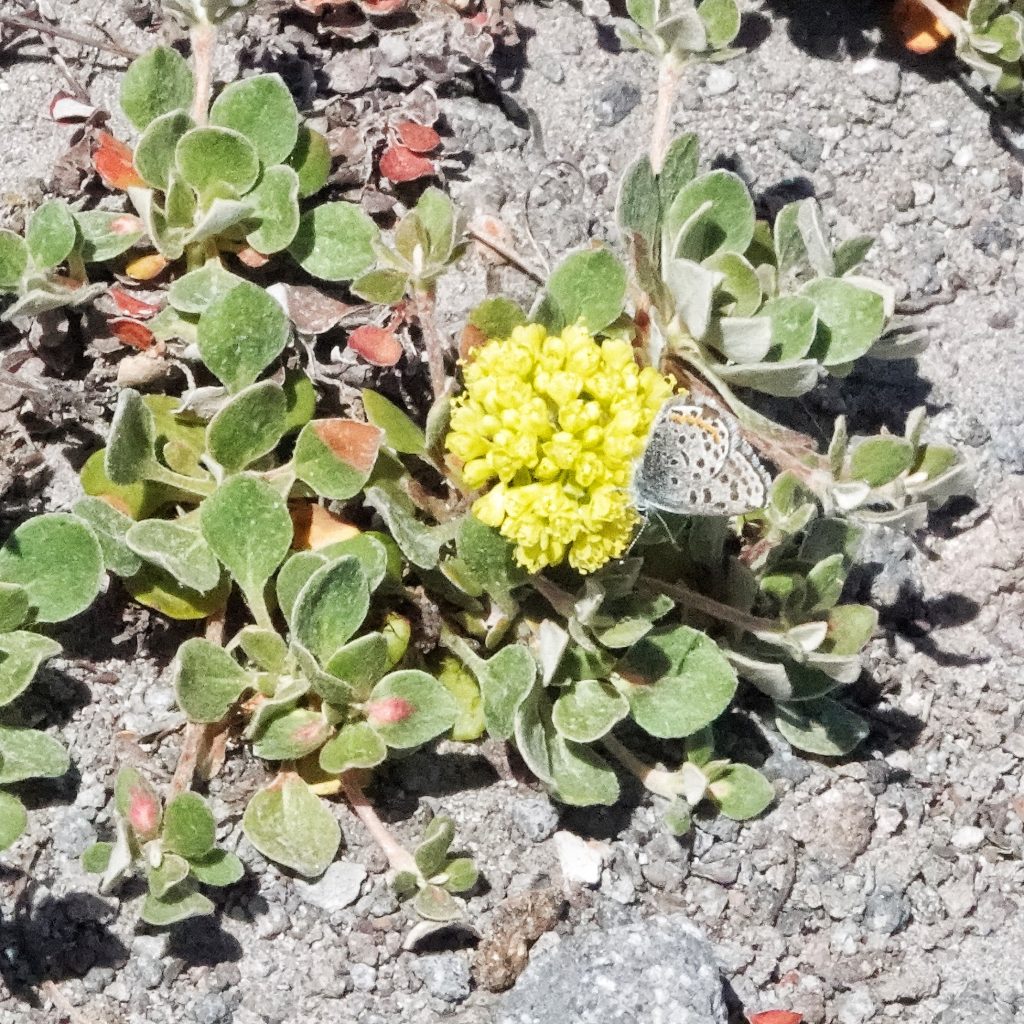
Description– Small (wingspan less than an inch) butterfly with many large spots on the ventral wing surface; ventral hindwing has two rows of black spots separated by a band of orange, and lack metallic spots (scintillae) on the margin; males are dorsally blue, with faint orange near the margin, and females are dorsally brown with obvious orange near the margin.
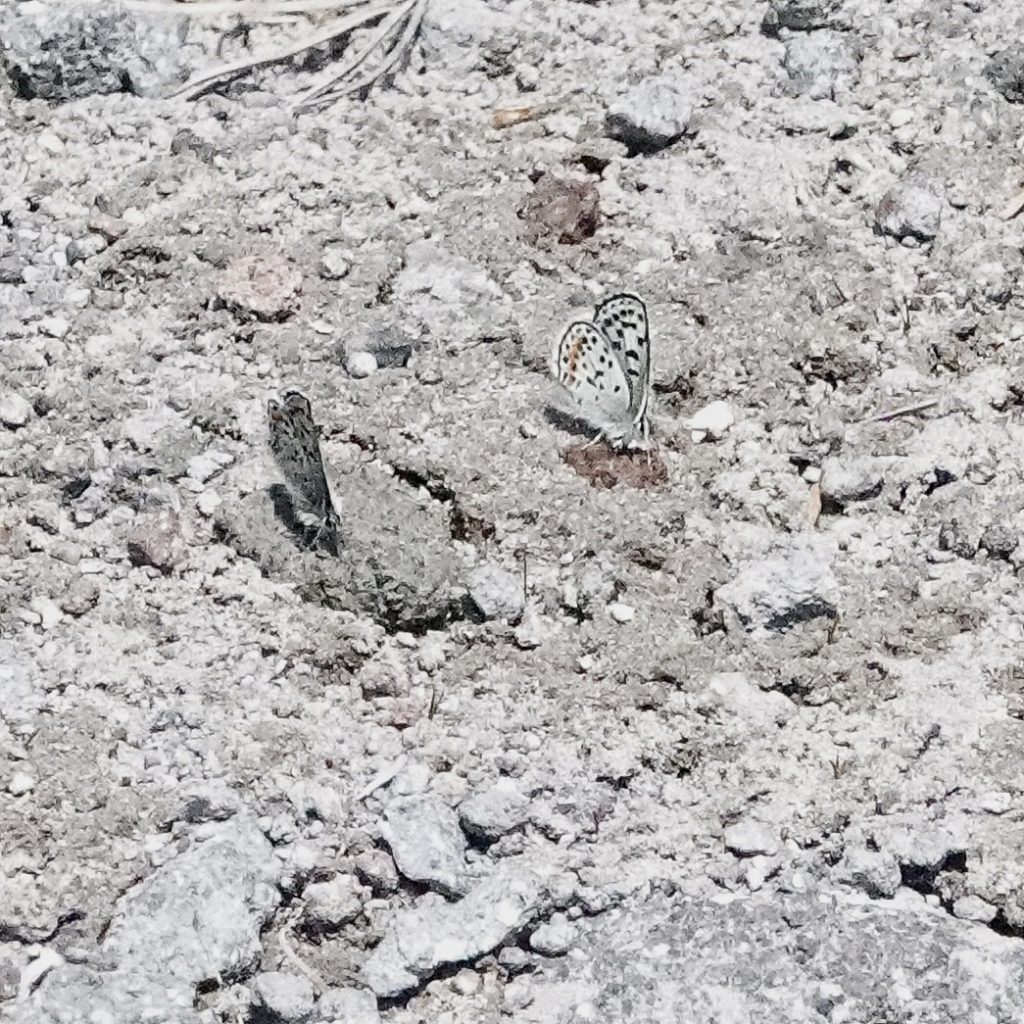
Similar species– Euphilotes spp. are best segregated by the species of wild buckwheat that they are found on; Icaricia acmon, I. lupini, and the undescribed Icaricia that Pyle/LaBar call a volcano blue, are all larger and have scintillae on the ventral hindwing margin; other blues either lack large spots ventrally, lack orange ventrally, or also have orange on the ventral forewing.
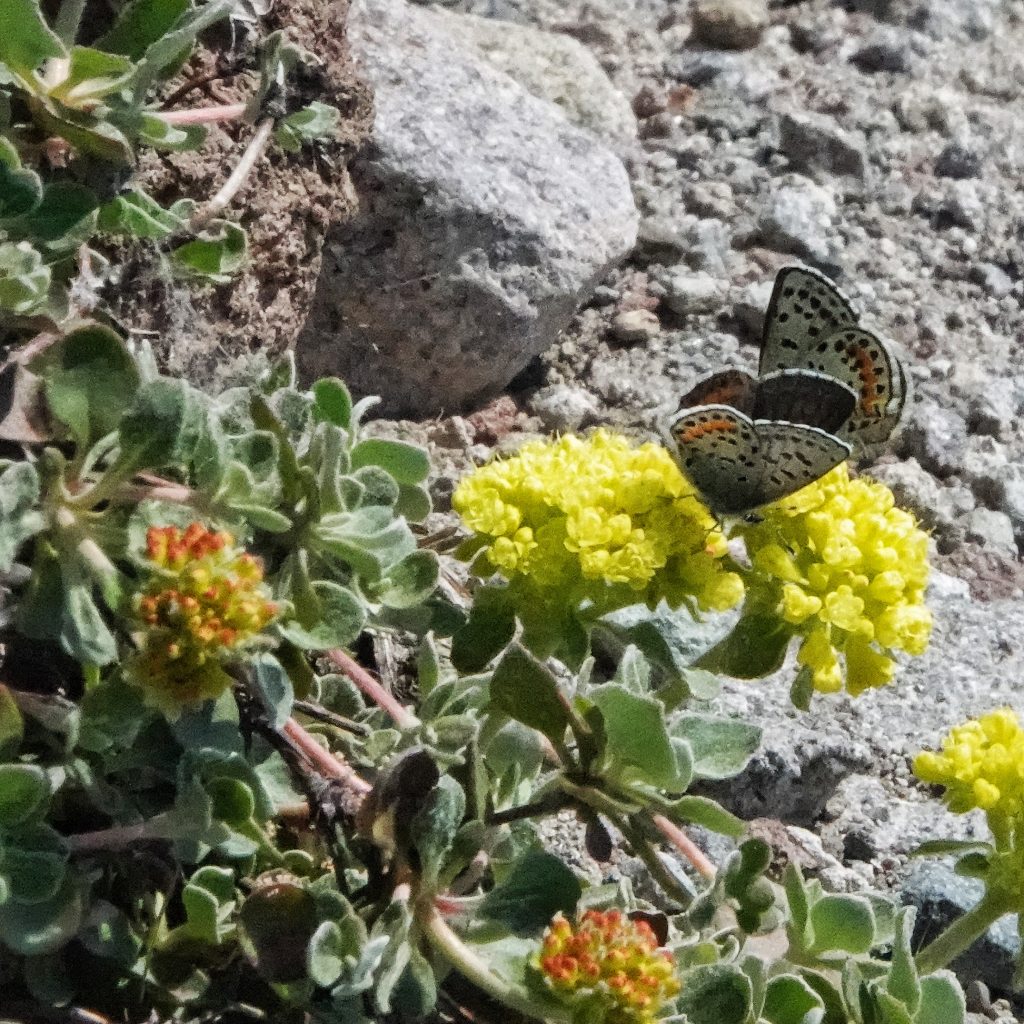
Habitat– Wherever Eriogonum umbellatum is found i.e., “Sulphur-flower buckwheat habitats include grasslands (Fig. 1), shrublands, woodlands (Fig. 2), and forests (Fig. 3) from near sea level to above treeline (Rose et al. 1998). It occurs frequently on dry, sandy to rocky sites with low to moderate annual precipitation (≥ 10 in [250 mm]). Plants are often widely scattered, but can be very abundant in some stands…”https://www.blm.gov/sites/blm.gov/files/ERUM_A.pdf
Range– Throughout the inter mountain West; rare to absent west of the Cascades, and Washington populations labeled as this may be a different species- otherwise region wide in appropriate habitat.
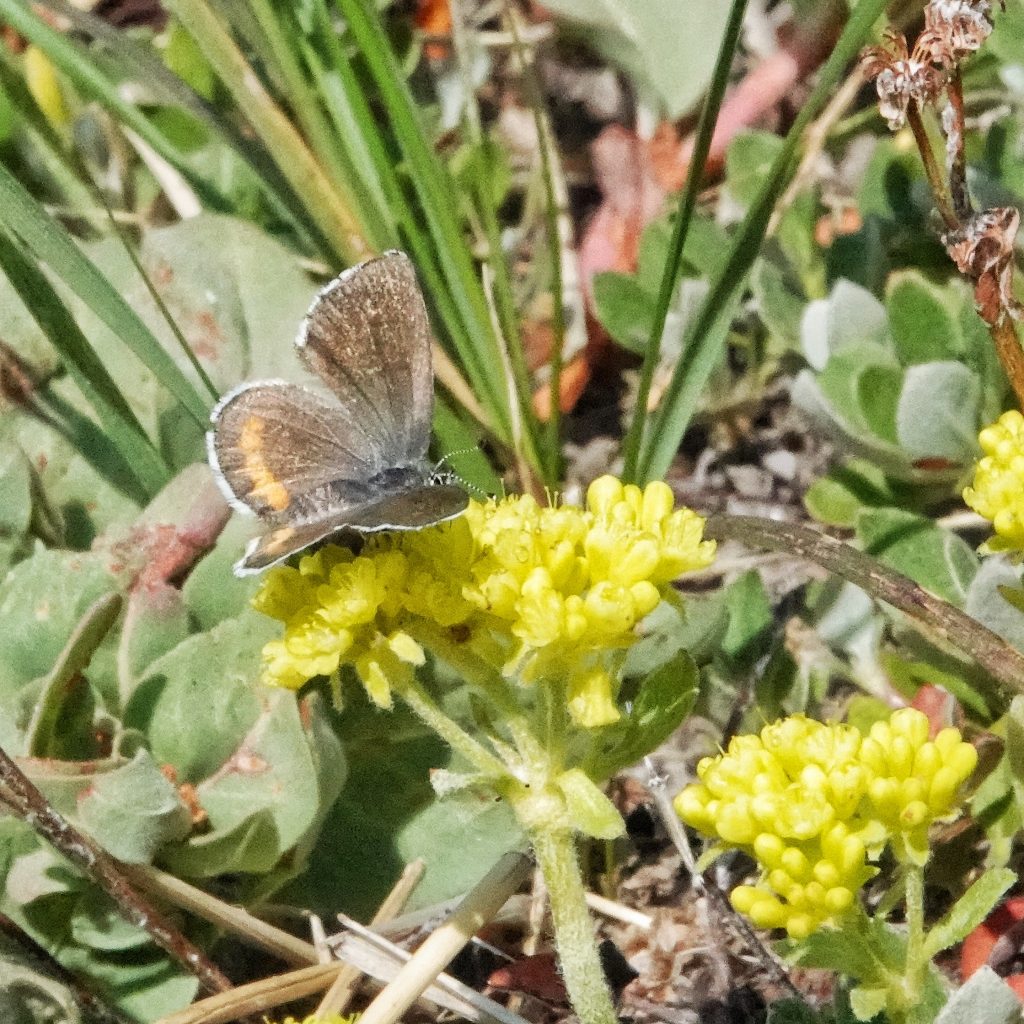
Eats– Larvae feed exclusively on the pollen and seeds of Eriogonum umbellatum , and adults nectar primarily at these plants.
Eaten by– Presumably a host for parasitoids in Hymenoptera and Diptera, and probably preyed upon by insectivores of all classes, but I can find nothing specific for this species; I did see a number of tachinid flies and ichneumonid wasps perched on or near the sulphur buckwheat.
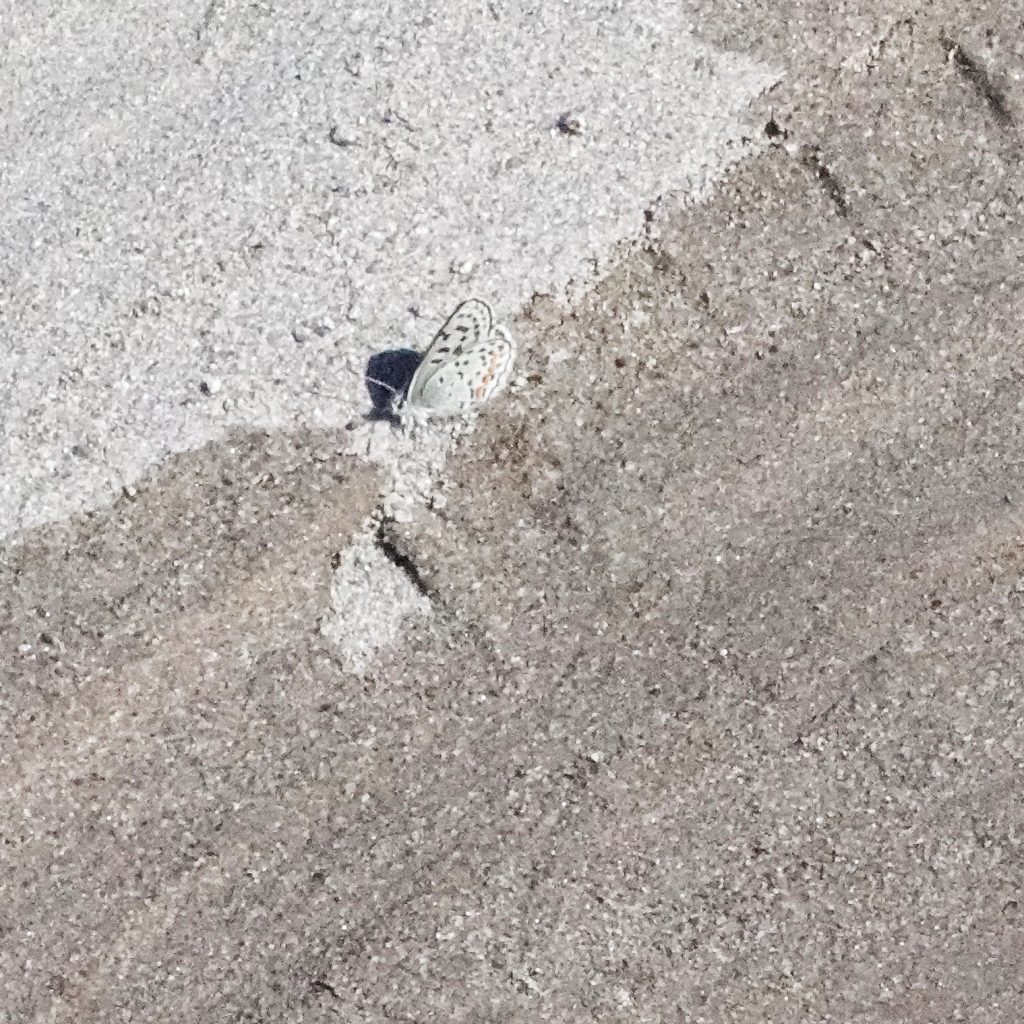
Life cycle– “Euphilotes taxa usually utilize closely related Eriogonum Michx. (Polygonaceae, Wild Buckwheat) species for mating, obtaining nectar, host-searching, and oviposition. Females ovipost upon young flowers. Larvae eclose three days later, feed on pollen, and switch to developing seeds where they feed until maturation. Once mature, the larvae crawl to the ground and burrow 4 to 12cm into the soil, where they pupate and in most cases enter diapause. Development time from oviposition to pupation takes about 21 days (Pratt, 1988) and most Eriogonum species bloom and fruit within about six weeks; thus there is only a three week period or less when females can successfully oviposit upon an Eriogonum species.” Sci-Hub | Evolution of <em>Euphilotes</em> (Lepidoptera: Lycaenidae) by seasonal and host shifts | 10.1111/j.1095-8312.1994.tb00970.x
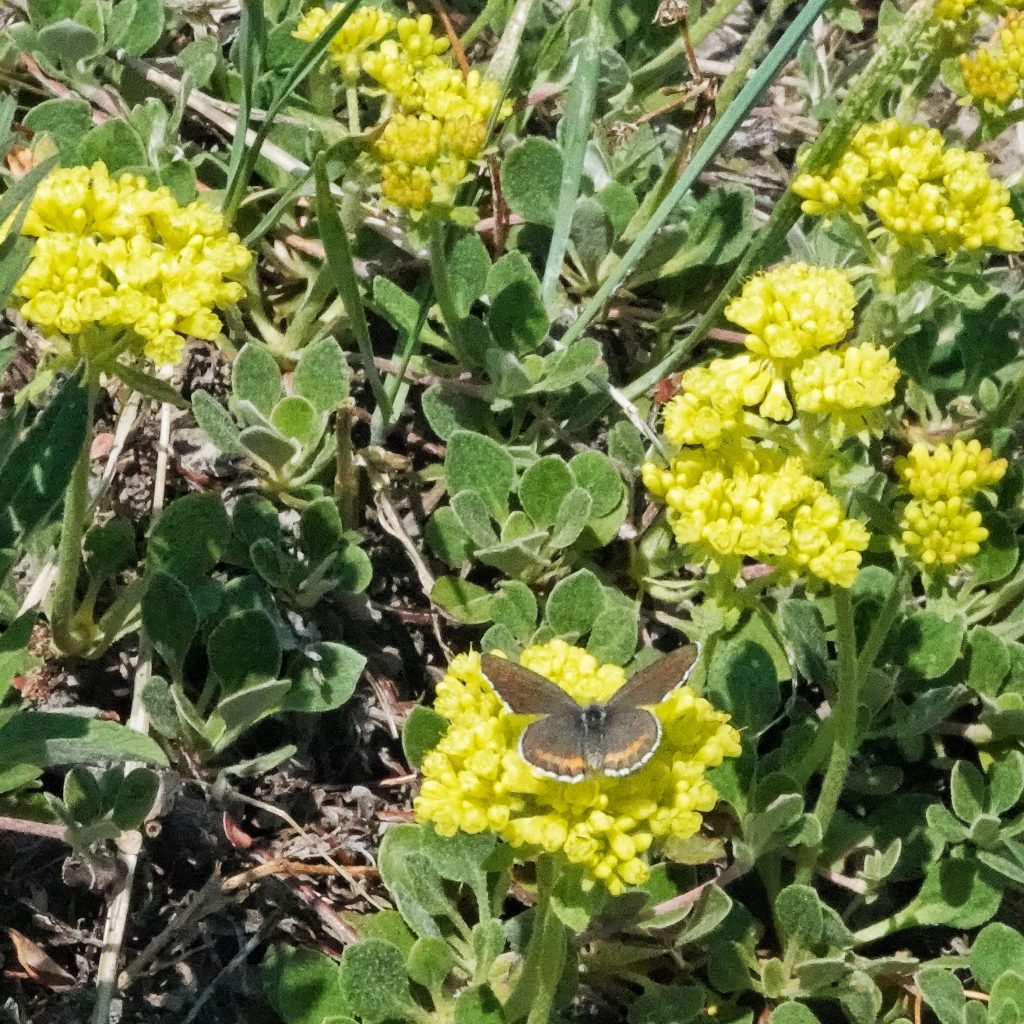
Adults active– Early May through mid-August, depending on elevation and latitude.
Etymology of names– Euphilotes is from the Greek word for ‘loving/fond of’, with the prefix for ‘good/true’, and the suffix for ‘having the quality of/being’, though what ‘being a true lover’ refers to is obscure, and the previous name of this genus was simply Philotes, ‘being a lover’. The specific epithet glaucon is from the Latin word for ‘blue grey’, and refers to the coloring.
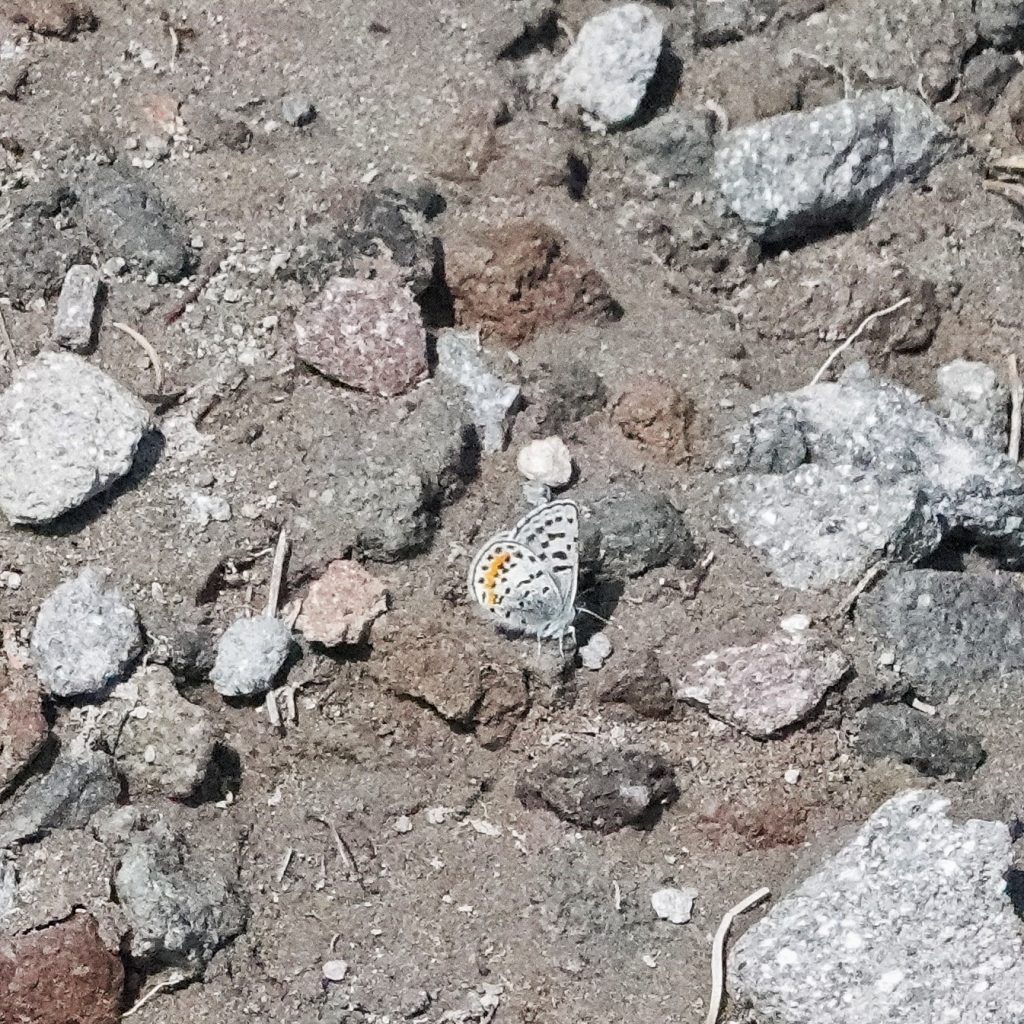
Glaucon Blue | ButterfliesofOregon
https://lepsurvey.carolinanature.com/ttr/ttr-5-1-supplement.pdf
Species Euphilotes glaucon – Glaucon Blue – Hodges#4366.1 – BugGuide.Net
http://mothphotographersgroup.msstate.edu/species.php?hodges=4366.1
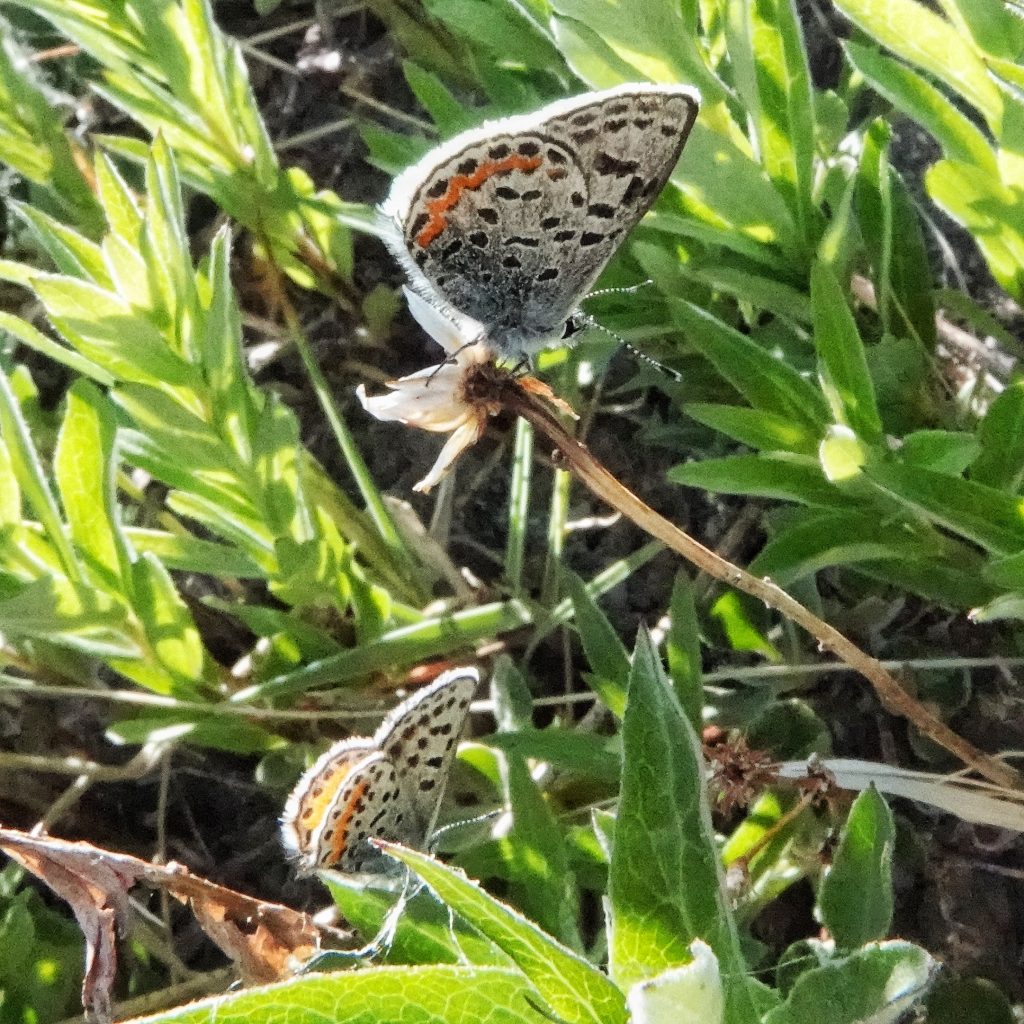
Dan, your accounts are really terrific, full of science as well as nature, and thank you for starting this project. I hope it gets many subscribers!
Thank you for your kind words, Dennis! And thank you for the resources you have given us to try to learn more about the creatures we share this world with!
Dennis, what good words! I just found Dan a bit ago– he is linked with WNPS FB, which I marginally moderate. Dan has such excellent findings. Like to chat with you– it’s been many years. I’m now ~Pendleton OR doing some botany in the Blue Mountains.
Thank you for saying that, Janet! I’m really glad to hear that you enjoy this site!
Oh my, Dennis Paulson! Dan’s posts made me think of you!! Be in contact please.